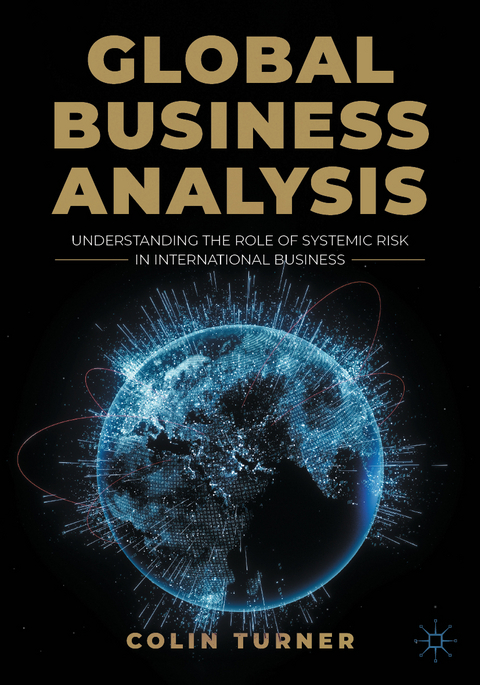
Global business analysis
Springer International Publishing (Verlag)
978-3-031-27768-9 (ISBN)
lt;p>One of the core functions of any successful business is the ability to manage and adapt to risk. In a global environment characterised by complexity, it is vital to be able to understand where risk lies and how it impacts upon business.
This textbook presents a series of meta-level trends, including as geo-political risks, climate change, and technology, and explores how they are forming and reshaping the risk environment of business. Using a mix of micro and macro level analysis, students will be able to understand how seemingly random, global events, pose challenges for firms.
Representing a bold sea-change in the study of international business, this book emphasises the practical elements that students will need to understand in order to succeed in the real world. Readers will not only learn how to understand and read risks in international markets, but they will also benefit from a tooklit to help them assess these processes. Ultimately, this textbook will furnish students with a full appreciation of the importance of risk in international systems.
Colin Turner is Associate Professor in International Management at Heriot Watt University, Scotland. He has authored/co-authored five books on infrastructure alongside numerous journal publications upon this subject matter. He is also co-author of two market leading textbooks on International and European Business: both of which are currently on their third editions. He has taught IB for nearly 30 years and has been at the forefront of many innovations in IB curriculum design and content.
lt;p>Chapter 1: The Nature of Risk in the International System
This chapter will seek to define the main concepts and frameworks to be utilised within this book. The form and nature of risk will be explored as will the multi-scalar nature of the international system. The chapter will offer initial explorations of the links between the two and outline the mains meta level risks/trends to be addressed within the rest of the book.
Chapter 2: Globalising the Business Model
This chapter will introduce readers to the concept of the business model as well as exploring the nature of risk within them. In so doing, the chapter will outline how globality places adaptive tensions upon business models by reshaping the context through which risk impacts upon a firm's value creating capabilities whether in terms of operations, markets, partners, etc.Chapter 3: The State in the International System
IB is based upon the operations of business between and within states. Thus on both a standalone basis - and as a result of interdependencies - an understanding of states as agents of change within the international system is needed. The chapter will assess the notions of how the state shapes and adapts to risk within the global system. The chapter will also look at different types of states and how risk tends to vary across them.
Chapter 4: Geo-economic RisksThese are risks to business sourced from shifts or changes in the global economic system that have an impact that is International in nature . Such changes can be either random or emerge as a result of processes within the global economy. The chapter will address the main forms of macro-economic risks that have the potential to impact upon the sustainability of business. Thus the chapter will look at patterns of growth, trade, investment and so on and explore how trends in these indicators alter the opportunities/risks faced by the global business system.
Chapter 5: Environmental Risks
This chapter will examine how long term changes in the natural environment are reshaping risks at the micro and macro level. This can be through naturally occurring events and processes that can impact upon international operations through disrupting supply chains etc. There is also the human sourced environment changes (such as climate change) and how policymakers and consumer concerns in this area is impacting (both negatively and positively) upon the operation of the international system.Chapter 6: Geopolitical risks
The ability of firms to operate across borders will in no small part be defined by the relationships between states. This matters to business as globally stretched supply chains are at risk of disruption should state relations decline. Consequently, geopolitics can have a large impact upon firm performance. This chapter will not only explore the broad consequence of geo-political risk for business but also examine the main geo-political processes currently at play within the global commercial system are shaping the risk environment for IB.Chapter 7: Societal Risks
Social risks have been emergent themes throughout the economic system shaped by a mix of factors such as changing demographics, inequality and immigration. This chapter in addressing these issues seeks to explore the main social tensions within the global system and how these are reshaping the effective operation of the international system. It will seek to assess the potential for instability from such processes as well as understanding the responses to such trends.
Chapter 8: Technological Risk
Businesses operate in shifting technological contexts has the potential to alter the risk context at both micro (for example commercial obsolescence) and macro (for example security) levels. The emergence of new technologies based on AI or the rise of additive manufacturing have the capability to reshape the form and nature of the international system and its operation. The chapter will identify the core themes in technological change and how such meta-trends are altering our understanding of IB.Chapter 9: Infrastructural Risk
Activity at both macro and micro levels operates in a complex spatial system that depends upon multi-level (national, international, etc.) infrastructures to support activity across space especially with increasingly elongated, complex supply chains. This exposes both businesses and state to risks created by disruption (either natural or human) to economic infrastructures. This chapter will seek to explore these risks not just within man-made structures but also across the global commons and how these can shape the value creating capability of the system.Chapter 10: International Business and Risk
This chapter will bring the analysis within the previous chapters together to develop a holistic perspective on risks within globalised business models. The chapter will seek to offer practical guidance in understanding how to assess risks within businesses that operate within increasingly complex international environments.
| Erscheinungsdatum | 22.09.2023 |
|---|---|
| Zusatzinfo | Illustrationen |
| Verlagsort | Cham |
| Sprache | englisch |
| Maße | 168 x 240 mm |
| Gewicht | 564 g |
| Einbandart | kartoniert |
| Themenwelt | Wirtschaft ► Betriebswirtschaft / Management ► Allgemeines / Lexika |
| Wirtschaft ► Betriebswirtschaft / Management ► Unternehmensführung / Management | |
| Schlagworte | Business Model • Geopolitical risk • Global environment • Internationalisation • Market Entry |
| ISBN-10 | 3-031-27768-6 / 3031277686 |
| ISBN-13 | 978-3-031-27768-9 / 9783031277689 |
| Zustand | Neuware |
| Haben Sie eine Frage zum Produkt? |
aus dem Bereich


